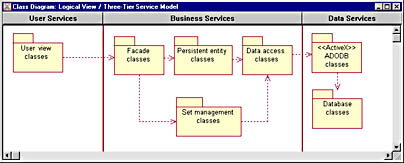Chapter 1 -- Planning for a New Architecture
Chapter 1
Windows DNA is Microsoft's platform for the development of distributed applications. Figure 1-1 shows an architectural overview of a typical Windows DNA application. We produced this view of an application using Rational Rose 2000. The symbols that look like folders in Figure 1-1 are called packages. They are, however, Unified Modeling Language (UML) packages and not Microsoft Transaction Server (MTS) packages. An MTS package is a container for components. You install your compiled MTS components in MTS packages. So an MTS package is a physical thing in a computer, whereas a UML package is a logical container within a UML model of classes that helps categorize the classes of a model. (Note that in Microsoft Windows 2000 the term package has changed to application and MTS has been renamed Component Services.)

Figure 1-1. Starting point for a scalable Windows DNA design.
The broken arrows between the UML packages represent dependencies between the packages. Figure 1-1 shows that objects within the User Views package depend on objects within the Use Case Facades package for their functionality. In other words, objects in the former package will call objects in the latter package. Looking at Figure 1-1, you might notice even at this high level of abstraction how object oriented this architecture is. The model includes a UML package of set management classes and another of persistent entity classes. (We'll describe these packages in the "Business Services" section later in this chapter.) The architecture shown in Figure 1-1 is a good example of what an object-oriented purist would come up with. We'll show you examples of more scalable designs later in this book.
In the next section, we'll explain this figure. Then we'll take a step-by-step journey toward a complete description of a very efficient and much more scalable architecture for Microsoft Windows NT and MTS or Microsoft Windows 2000 and COM+ business applications.
EAN: 2147483647
Pages: 133